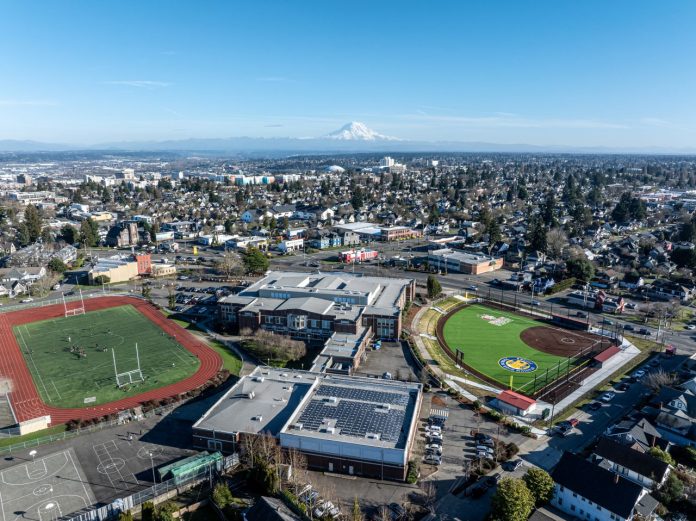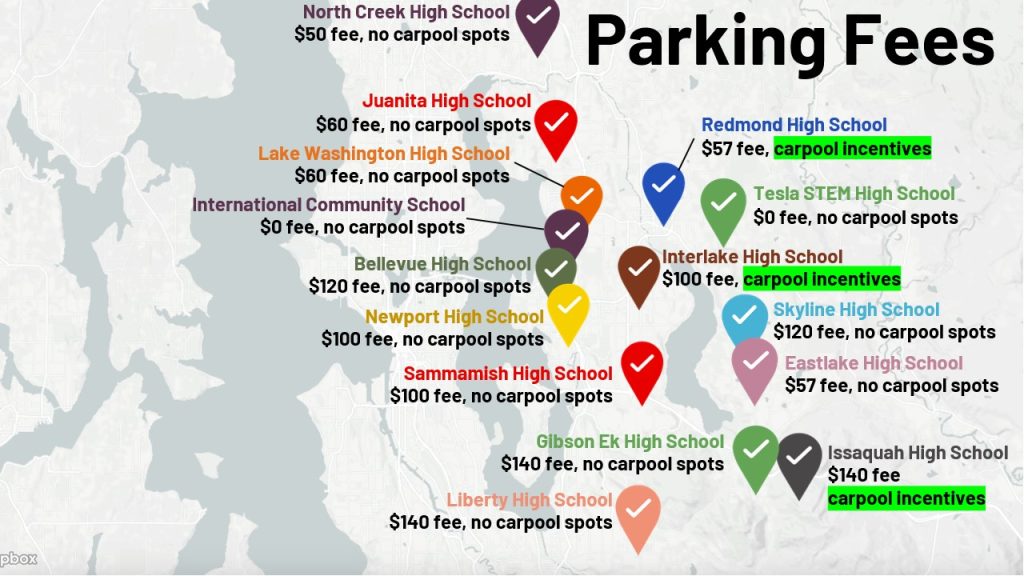
Two weeks before the start of school you are standing in line to buy a parking pass. There are 2,000 students at your high school, but the parking lot only has 275 spaces for students.
The girl in front of you drives an electric vehicle, which her family bought because it emits less carbon. The boy behind you has been carpooling consistently since sophomore year. You, like many others, drive to school by yourself in a standard gas car.
Parking passes are issued first-come-first-served, and seniors get first priority. There is no consideration for who is contributing less to traffic jams, air pollution, or parking lot crowding. The EV driver pays the same as the carpooler who pays the same as you.
What if we could incentivize students to reduce emissions and congestion by carpooling?
King County has a goal to reduce county-wide carbon emissions 50% by 2030 from a 2007 baseline. Their Strategic Climate Action Plan calls for reducing car trips to lower transportation emissions. Sustainability policies adopted by the Issaquah, Bellevue, and Lake Washington school districts reinforce these carbon reduction goals, opening the door for student-focused strategies.
When it comes to environmentally-friendly forms of transportation, nothing beats walking, biking, or riding an e-scooter. Taking public transportation also reduces one’s emissions. Many students who live close to school, have access to safe biking infrastructure, or live near a bus route are already walking, biking, and using transit. But what about the students who aren’t?
Students who do have to drive should consider carpooling to cut their emissions and reduce traffic congestion. But right now most schools offer no incentives for students to carpool.
Fifteen high schools in King County sent us data on their current parking fees and carpooling incentives. Only three have carpooling incentives: Issaquah, Redmond, and Interlake high schools.

Issaquah High School prioritizes carpooling in their permitting process by allowing students to register multiple vehicles under one permit, and students can split the $140 fee amongst those in their carpool.
At Redmond High School carpools are assigned a designated stall in their carpool lot and the permit fee is half-price. Two cars can be registered per permit, so two students are able to switch off driving responsibilities throughout the year.
At Interlake High School, students who are in a three-person or larger carpool are given priority in securing a $100 permit. This means that students who carpool will be given a permit until they run out of available spaces. Students who do not carpool are placed in a lottery to have the chance to get a permit.
The other twelve schools we collected data from do not offer any incentives to carpool. Instead students are charged a flat rate ranging anywhere from $50, like at North Creek High School, up to $140, like at Gibson Ek and Liberty high schools. Choice schools, like Tesla STEM and International Community School, do not even charge students a fee to park.
Issaquah, Redmond, and Interlake high schools show that carpooling can be incentivized — something other schools could adopt to align with climate goals.
Recommended policy changes:
- Cut parking permit fees in half for verified carpoolers.
- Give carpoolers priority in receiving parking permits before solo drivers.
- Increase fees for single-occupant vehicles to reflect their higher per-person environmental impact.
If 25% of student drivers began carpooling, the environmental impact would be significant. For example, Juanita High School has an average of 300 student drivers, so that would be 75 students carpooling. Assuming each carpool is just two students that would reduce the number of cars by 37 each day. If each car emits 3.5 pounds of CO₂ daily on a four-mile round trip, this shift would cut 130 pounds of climate pollution every school day. Over a 180-day school year, that amounts to almost 11 metric tons of CO₂ avoided. That’s equivalent to avoiding 17 flights between Seattle and New York!
If 25% of students at our fifteen surveyed high schools made this change it would prevent 171 metric tons of carbon emissions. There are 83 high schools in King County. Imagine how much we could reduce our emissions if just a quarter of student drivers carpooled to school.
How students commute to school matters.
Belle Marlar (Guest Contributor)
Belle Marlar is a senior at Juanita High School in Kirkland, this is her first piece with Sustainability Ambassadors, a professional development program for student leaders committed to rapidly advancing a sustainable future.
